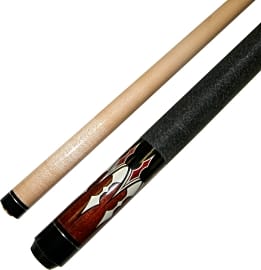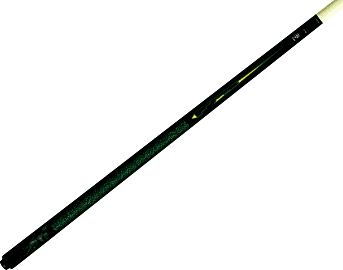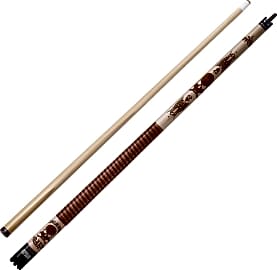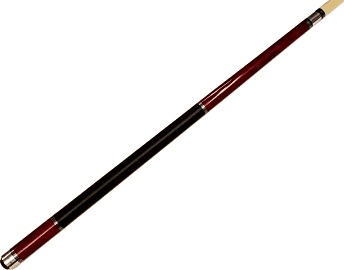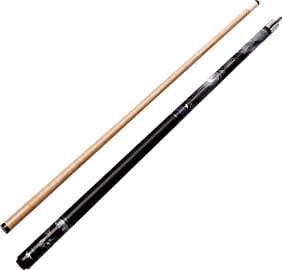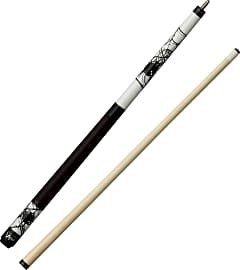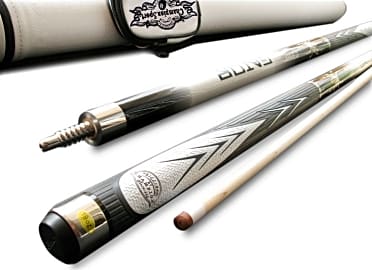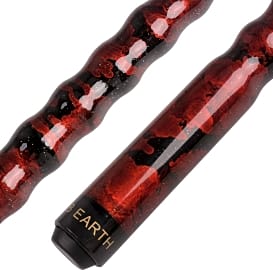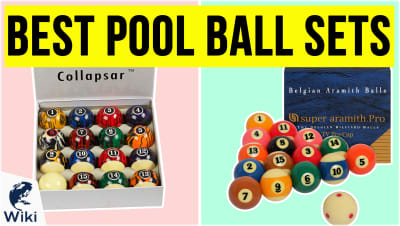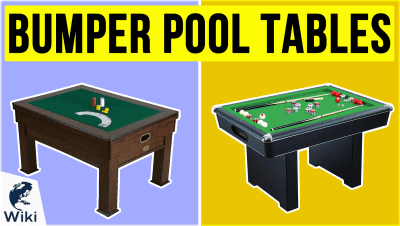The 10 Best Pool Cues

This wiki has been updated 42 times since it was first published in July of 2015. Step your pool game up to hustler level by picking up one of these stylish cues for your next visit to the billiards table. We've selected a range of options, from affordable models suitable for home use to professional-quality sticks good enough for tournament play. We also made sure to include a few choices for the junior players out there. Just make sure that you don't forget the chalk. When users buy our independently chosen editorial picks, we may earn commissions to help fund the Wiki.
Editor's Notes
October 20, 2020:
Since using a cue to strike billiard balls has been popular since the 1800's, it is hardly surprising that the design of modern cues doesn't change very much. In this most recent update, we have removed two models due to availability issues. We replaced the EastPoint Sports Composite, which was our budget choice, with the AB Earth Ergonomic. The latter is still in the same price range, however, this one has a maple body over the fiberglass body of the previous choice. It also features a contoured base that provides a good grip, and is hand-painted, making it surprisingly good value for a beginner's cue. We also removed the McDermott G213 and in its place selected the McDermott L65. Both of these cues are at the lower end of the scale for McDermott, yet they have many of the same features as their more costly, premium counterparts. The L65 is notable for its intricate green and black coloring and leprechaun motif on the base.
May 09, 2019:
As with any sport (yes, we consider billiards to be a sport), using quality equipment can make a big difference in how well you play. When it comes to pool, everything else being equal, the cue can be the deciding factor in how straight your ball rolls. Experienced players understand this, which is why they don't mind spending money on a premium stick that can help them seriously improve their game, such as the Players Technology Series HXT15, McDermott G213, and Viper Desperado. All three of these models will offer a high degree of ball control, good hit feedback, and look as good as anything you see the pros use on TV. Moving down a step in both quality and price, we have the Players C-960,Viper Underground Raven, and Viking Valhalla. We would consider these ideal for intermediate players who can tell the difference between a good, well-balanced stick and those poor excuses for cues you find at your average pool hall. Unlike the more premium options, these are more affordable for the average person who isn't ready to outlay large sums of money. In this category you can expect arrow-straight shafts that won't warp over time, quality stainless steel joints, and glue-in tips. Both the Viper Junior and Iszy Billiards are good options for young kids interested in billiards, since they are just 48-inches long. Of these two, the Viper Junior is the better built stick. Finally, for the average users who just wants to buy a few decent cues for their home table or who can no longer stand using those warped, pieces of junk you find at pool halls, we have included the affordable EastPoint Sports Composite.
Special Honors
McDermott G2201 Ranked as 2019's cue of the year, it is hard to go wrong with this premium offering from one of game's most respected cue manufacturers. It features eight sets of abalone, turquoise, pewter and black urethane points; a black, lizard-embossed leather wrap; and a cocobolo sleeve. Making it play just as good as it looks, it is equipped with a high-performance shaft that can help produce more spin, better accuracy at all speeds, and optimal energy transfer from the stick to the ball. mcdermottcue.com
Predator Ikon3-5 This stick is crafted with the company's patented C4+ technology, which means it has four perfectly formed wedges slipped into a sleeve of exotic wood, in this case cocobolo, and is reinforced with phenolic. Any experienced player who gives this cue a shot will immediately notice the solid feel when it makes contact with the ball. predatorcues.com
A Brief History Of Pool
Whether you call it pool, snooker, or you opt for the umbrella term of cue sports, if you like to play table games involving balls and cues, you're part of a long tradition.
Whether you call it pool, snooker, or you opt for the umbrella term of cue sports, if you like to play table games involving balls and cues, you're part of a long tradition. Cue sports have been enjoyed for more than six hundred years, originating as games played outdoors on grass, dirt, or sand pitches. Many indoor, table play varieties of cue and ball games can be traced to the Renaissance years, and were developed and refined well into the modern era.
There are a few distinctions to be made between the game of pool and the game of billiards, but the chief difference is that in the latter, billiards, there are no pockets in the table. In billiards, points are scored when a player makes the cue ball touch his or her ball and the opponent's ball in a given order. Pool involves a table with pockets, and a player wins the game by sinking balls into the pockets in the orders dictated by the chosen game. For the purposes of our discussion, we will use the word "pool" exclusively, but know that the terms pool billiards and pocket billiards refer to the same activity.
Pool has been enjoyed in the United States for centuries, but was traditionally a pastime reserved for the well-heeled upper classes. Pool halls became ever more prevalent throughout the course of the 19th Century, however, and greater public access to the sport democratized and popularized it among the working classes.
The standard American game of pool involves balls that are 2.25-inches in diameter and are usually made from a synthetic phenolic resin that resist chipping and cracking even with the forceful impacts associated with the game of pool. (Balls were traditionally made from elephant ivory, a practice which saw the tragic death of countless animals well into the 1900s.) The most popular variation of pool is known as Eight-Ball, a game usually matching two players in head-to-head competition and that is played with fifteen balls on the table. Each player is assigned a suit, either stripes or solids, based on an initial break, and then the players must subsequently sink their balls into pockets, saving the eight ball for the final shot of the game.
Over the years, pool has seen its share of stars, many of whom have earned fortunes playing the game. It has also spawned its share of lore and legend, such as the mythical hustler Minnesota Fats: though arguably the most famous pool shark of all times, Minnesota Fats is simply the nickname of the fictional character George Hegerman who was created by author Walter Tevis.
Choosing The Right Pool Cue For You
All pool cues look about the same: they are long and slender and taper from a thicker handle to a narrow, blunt tip which is used to drive the cue ball toward its intended target. A pool cue consists of three primary sections: the tip (which can be divided into the cap at the end and the ferrule section connecting it to the rest of the shaft), the shaft, which is the longer, narrower part of the cue, and the butt, which consists of about 40 perfect of the cue's overall length.
Unlike one might find with tennis racquets or golf clubs, there are few ways to alter or refine the design of a pool cue.
Unlike one might find with tennis racquets or golf clubs, there are few ways to alter or refine the design of a pool cue. Rather the quest for the best cue for a given player comes down primarily to the matter of weight and length. An average pool cue -- also occasionally called a cue stick -- is 58 inches in length (based on the standard range of official cues, which are between 57 and 59 inches long) and weighs anywhere from 16 to 21 ounces. Most experienced players choose a cue with a midrange weight of 19 ounces.
Most pool cues are made from maple wood, though ash is also occasionally used. Make is a straight grained wood that allows for reliably straight shafts. You can opt for a cue made from various synthetic materials if desired, but these cues offer no benefit in terms of power or accuracy, and a traditional maple cue is usually advisable. Players of smaller stature should choose a shorter, lighter weight cue, and larger players should opt for longer cues with more heft. If you frequently play in pool halls, competitions, or simply in friends' homes, then choosing a stick which can be broken down into sections makes sense. If you are choosing a cue only for use in your own home, a cue that comes in a single solid piece makes more sense, as it is less prone to breaking.
Pool Cue Care And Maintenance
Always store your pool cue vertically. This is true whether it is a single, solid unit or it is a cue that breaks down into sections. Storing the cue upright will help to prevent it from bowing with age.
With most cues, the only part that will ever have to be replaced is the very tip that actually strikes the cue ball; regularly replacing this tip helps keep the pressure distributed down the rest of the cue even, ensuring it will last for years. Properly chalking your cue's tip also helps you deliver even, solid strikes that will preserve your cue.
If you bring your cue on the road with you, make sure to pack it into a case with soft lining that holds it firmly in place. The more the cue clatters around inside a case, the less it will help deliver accurate shots on the table.
And if you ever do notice that your cue is bending or cracked, it's time to hang it up for a new stick.


